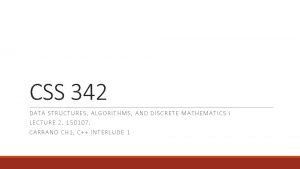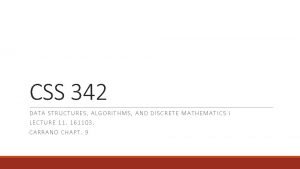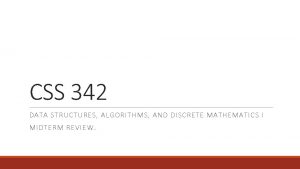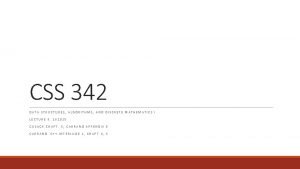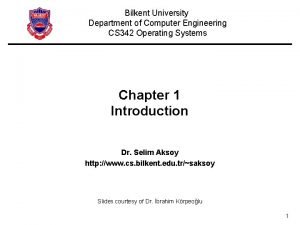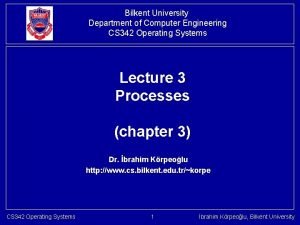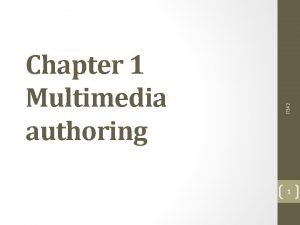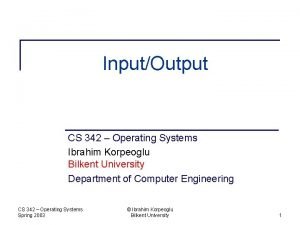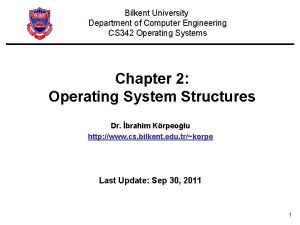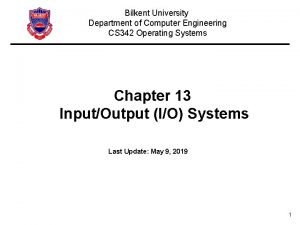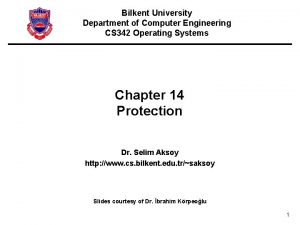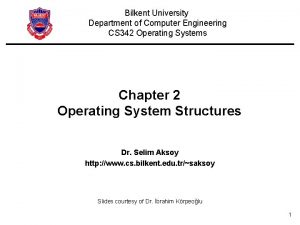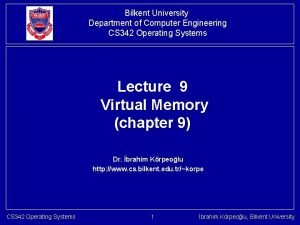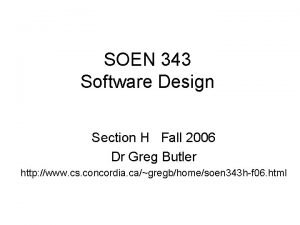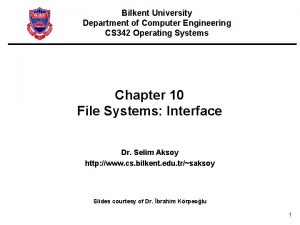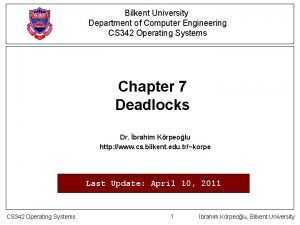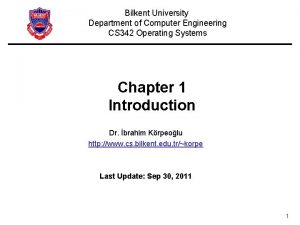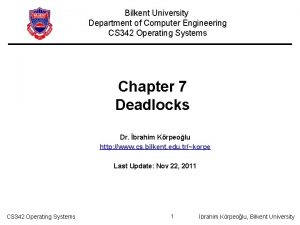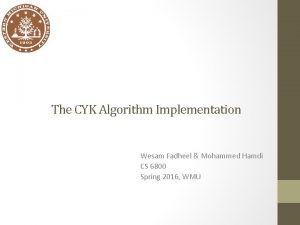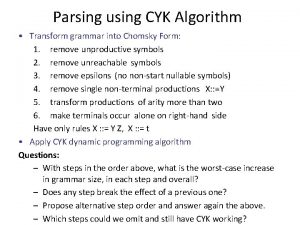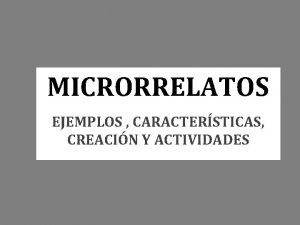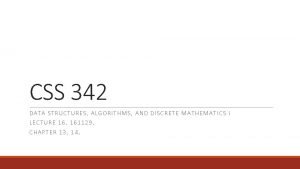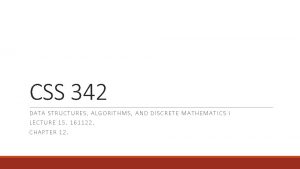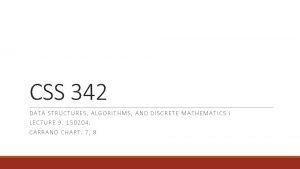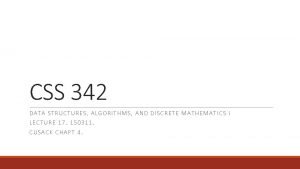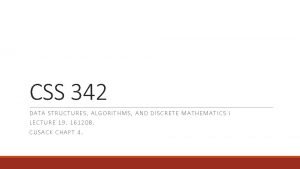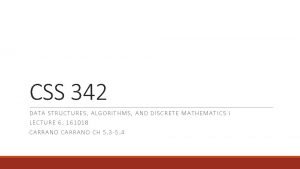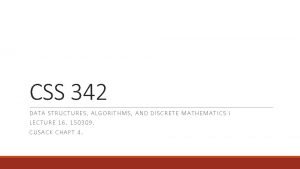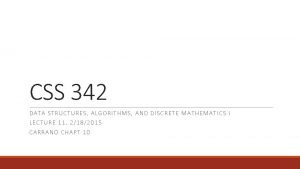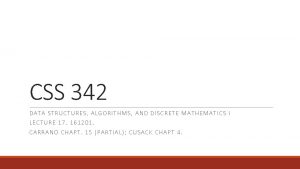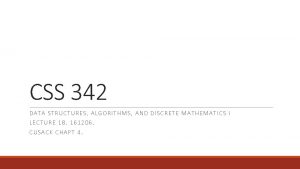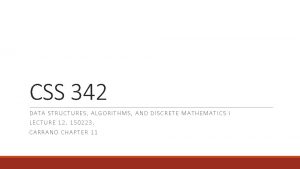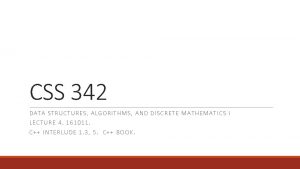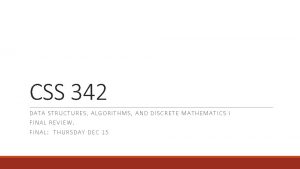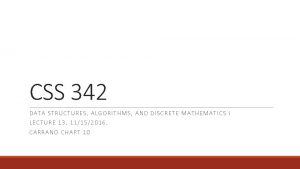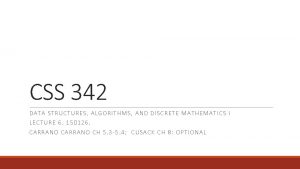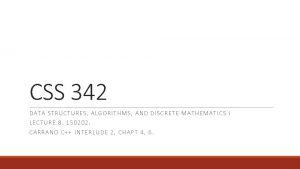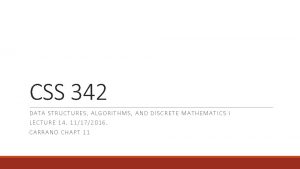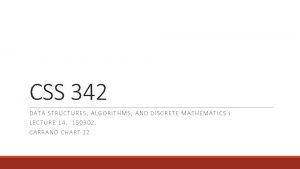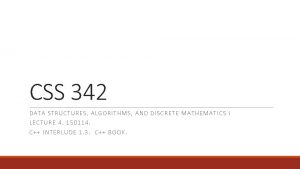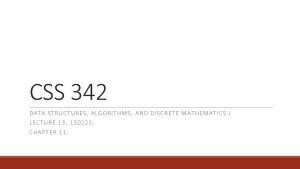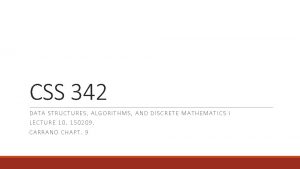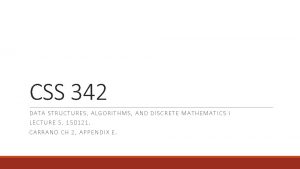CSS 342 DATA S TR U CTURES ALGO




























![Unix Message Queues struct mymesg { long mytype; char mtext[512]; } message_body; int main( Unix Message Queues struct mymesg { long mytype; char mtext[512]; } message_body; int main(](https://slidetodoc.com/presentation_image/4e9c4ba082c5f4a7ec258ba248e4f74f/image-29.jpg)



- Slides: 32

CSS 342 DATA S TR U CTURES, ALGO RITHMS , AND DISCRETE MATHEMATICS I LECTU RE 15. 150304. CHAPT ER 13, 14.

Agenda • Code example from last time • STL • Topic: Queues • Peer Review of Lab 5 Design • Announcement: Please bring computers on Monday

Write a member function, Move. To. End which takes in an item by value, finds the first occurrence and moves it to the end of the list. Return false if item could not be found; otherwise true.

bool My. List: : Move. To. End(Item it) { Node *current = head; Node *p. Found = NULL; if (current == NULL) { return false; } while ((current != NULL) && (p. Found == NULL)) { if (*(current->p. Item) == it) { p. Found = current; } else { current = current->next; } } if (p. Found == NULL) { return false; } while (current->next != NULL) { current = current->next; } Item *temp = current->p. Item; current->p. Item = p. Found->p. Item; p. Found->p. Item = temp; }

STL WHY REINVENT THE WHEEL?

STL Sequence Containers: The Big 3 • Vector • • Flexibly sized array Access any element in constant time (index into array) Add/Remove from the end of array Data kept contiguous in memory • Deque • • Double ended queue Can add/look from front or back Access any element in constant time Not guaranteed to be contiguous in memory • List • Linked list • Need iterator to traverse • Can add anywhere in list in constant time

Recall the stack • Last In First Out (LIFO) • We implemented with following structures: push • Array • Linked List • (a. Stack. push(new. Item)). pop() is equal to a. Stack • STL has a stack implementation as a Container Adapter • Container adapter on vector, deque, or list • Default is deque • Functions: empty, size, push, pop, top pop

int main( ) { stack<int> a. Stack; stack<int, vector<int>> b. Stack; for (int i = 0; i < 3; i++) { b. Stack. push(i); } cout << "stack size is: " << b. Stack. size() << endl; cout << "top element is: " << b. Stack. top() << endl; b. Stack. pop(); cout << "Popped! " << endl; cout << "top element is: " << b. Stack. top() << endl; return 0; }

Queues

Queue • First in First Out (FIFO) • Can be implemented with Time = 0 • Array • Linked List • (a. Q. push(new. Item)). pop() != a. Q Time = 12 • Uses • Many: powerful data structures for impls. • Often used for short lived (in-memory) or persistent applications (written to disk) • Modeling: Rich field on queueing theory/modeling CSS 342: QUEUES Time = 20 Time = 38 10

Queue Specification • STL has a stack implementation as a Container Adapter • Container adapter on vector, deque, or list • Default is deque • Functions: empty, size, push, pop, back, front pop( ): remove and get the front item push() to the back(): get the back item but do not remove it Front(): get the front item but do not remove it

int main( ) { queue<int> a. Q; for (int i = 0; i < 5; i++) { a. Q. push(i); } cout << "Queue size is: " << a. Q. size() << endl; cout << "Front element is: " << a. Q. front() << endl; cout << "Back element is: " << a. Q. back() << endl; a. Q. pop(); cout << "Popped! " << endl; cout << "Front element is: " << a. Q. front() << endl; cout << "Back element is: " << a. Q. back() << endl; return 0; }

Comparison of Stack and Queue Operations • size, empty, push, pop, =, comparators are all common syntax • Both are adapters which can be built on containter classes • Differences: • stack: top • queue: front, back • Semantics: LIFO, FIFO

Queue implementation • Array Based • Pointer based • Can we make a queue from lists? • How can we make a queue Persistent?

Computer Scientist of the week Gary Kildall Born in Seattle UW Graduate, Ph. D in 1972 Created CP/M Operating System Created BIOS: Basic Input Output System Allow microprocessor to communicate with disk drive! DRI (Kildall) and IBM negotiated about usage of CP/M but did not reach a deal • PC-DOS soon followed • General controversy on whether any infringements occurred • • •

An Array-Based Implementation 0 k front back 47 2 4 1 0 1 2 49 front back …. . 1 2 …. . k …. . 0 7 the. Array. size( )-1 4 10 7 47 48 49 the. Array. size( )-1 1) Shift left on each removal? 2) Shift left when end of queue is reached? 3) Never Shift but maintain moving front and back pointers? 4) Allocate new array when full?

Circular-array implementation front 0 the. Array. size( )-1 2 4 1 7 1 2 3 back

MAX_Q-1 (1) 0 front back (2) 7 count = 0 back 2 count = 2 3 3 MAX_Q-1 0 (4) 1 4 2 9 1 6 Enqueue(7) Enqueue(6) 2 Enqueue(3) back Enqueue(8) Enqueue(9) Dequeue() Enqueue(2) Dequeue(4) Dequeue() count = 5 front 0 1 Initial state (3) MAX_Q-1 8 3 3 2 front MAX_Q-1 0 while (the. Q. size()) back { front Dequeue() } 1 2 count = 0 3

Contract (. h) class My. Queue { public: My. Queue(); ~My. Queue(); bool is. Empty() const; int get. Count() const; int Dequeue() throw (exception); void Enqueue(const int &val); private: vector<int> arr; int front; int back; int count; void double. Queue. Size(); };

My. Queue: : My. Queue() { arr. resize(ARRAY_START_SIZE); front = 0; back = arr. size() - 1; count = 0; } void My. Queue: : double. Queue. Size() { } int My. Queue: : get. Count() const { return count; } bool My. Queue: : is. Empty() const { if (count == 0) { return true; } else { return false; } }

void My. Queue: : Enqueue(const int &val) { if (count == arr. size()) { double. Queue. Size(); } back = (back + 1) % arr. size(); arr[back] = val; count++; } int My. Queue: : Dequeue() throw (exception) { int ret. Val; if (count > 0) { ret. Val = arr[front]; front = (front + 1) % arr. size(); count--; return ret. Val; } else { throw exception("Queue Empty"); } }

Peer design review of lab 5…

A Pointer-Based Implementation 2 front 4 1 7 back NULL

class My. Queue { public: My. Queue(); ~My. Queue(); bool is. Empty() const; int get. Count() const; int Dequeue() throw (exception); void Enqueue(const int &val); private: struct Node { int val; Node *next = NULL; }; Node *front; Node *back; int count; };

My. Queue: : My. Queue() { front = NULL; back = NULL; count = 0; } My. Queue: : ~My. Queue() { while (get. Count() > 0) { Dequeue(); } } bool My. Queue: : is. Empty() const { if (front == NULL) { return true; } else { return false; } } int My. Queue: : get. Count() const { return count; }

void My. Queue: : Enqueue(const int &value) { Node *ins. Node; ins. Node = new Node; ins. Node->val = value; if (count == 0) { back = ins. Node; front = ins. Node; } else { back->next = ins. Node; back = ins. Node; } count++; } int My. Queue: : Dequeue() throw (exception) { if (count == 0) { throw exception("Queue is empty"); } Node *temp = front; int ret. Val = temp->val; front = front->next; delete temp; if (count == 1) { back == NULL; } count--; return ret. Val; }

Are we done? • Do we need to overload =, copy constructor? • Why or why not? • Any other overloads?

Queue usage in OS, Network, Services • Message queues • Scheduling queue • TCP Flow control • Payment processing
![Unix Message Queues struct mymesg long mytype char mtext512 messagebody int main Unix Message Queues struct mymesg { long mytype; char mtext[512]; } message_body; int main(](https://slidetodoc.com/presentation_image/4e9c4ba082c5f4a7ec258ba248e4f74f/image-29.jpg)
Unix Message Queues struct mymesg { long mytype; char mtext[512]; } message_body; int main( void ) { int msgid = msgget( 100, IPC_CREAT ); strcpy( message_body. mtext, “hello worldn” ); msgsnd( msgid, &message_body, 512, 0 ); } int main( void ) { int msgid = msgget( 100, IPC_CREAT ); msgrcv( msgid, &message_body, 512, 0, 0 ); cout << message_body. mtext << endl; } Message queue (id = msgid) 0 1 2 Some other process can enqueue and dequeue a message

Multilevel Queue Scheduling • Each queue has its own scheduling algorithm, – foreground (interactive) – RR, 80% CPU time – background (batch) – FCFS, 20% CPU time

Multilevel Feedback-Queue Scheduling • • A new job enters queue Q 0 which is served FCFS. When it gains CPU, job receives 8 milliseconds. If it does not finish in 8 milliseconds, job is moved to queue Q 1. At Q 1 job is again served FCFS and receives 16 additional milliseconds. If it still does not complete, it is preempted and moved to queue Q 2.

Flow Control Sending application Receiving application packet Send Socket Buffer Receive Socket Buffer send ack read blocked X packet retransmitted packet dropped packet retransmitted packet dropped X write blocked X X Application is slow to read.
 Css 342
Css 342 Ctures
Ctures Css 342
Css 342 Css342 pdf
Css342 pdf De 2501 part b
De 2501 part b Cs 342
Cs 342 Bilkent cs342
Bilkent cs342 It 342
It 342 Ibrahim korpeoglu
Ibrahim korpeoglu Emre uzun bilkent
Emre uzun bilkent 450 onluğa yuvarlama
450 onluğa yuvarlama Delta studio valea cascadelor
Delta studio valea cascadelor Cs 342 bilkent
Cs 342 bilkent Cs 342 bilkent
Cs 342 bilkent Cs342 bilkent
Cs342 bilkent Cs 342 bilkent
Cs 342 bilkent Cs 342 bilkent
Cs 342 bilkent Ie 342 bilkent
Ie 342 bilkent Jesus é meu amigo, meu guia, meu senhor
Jesus é meu amigo, meu guia, meu senhor 342 3
342 3 Krs 342
Krs 342 Soen 342
Soen 342 It 342
It 342 Cs 342 bilkent
Cs 342 bilkent Cs 342 bilkent
Cs 342 bilkent Bilkent cs
Bilkent cs Cs 342 bilkent
Cs 342 bilkent Todo chiste en el fondo encubre una verdad
Todo chiste en el fondo encubre una verdad Dr cyk
Dr cyk Que es algo soluble
Que es algo soluble Cyk algorithm
Cyk algorithm Construimos microrrelatos chistosos con la palabra capaz
Construimos microrrelatos chistosos con la palabra capaz Hay algo que aunque te pertenece
Hay algo que aunque te pertenece
